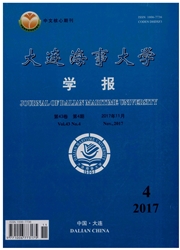

 中文摘要:
中文摘要:
为实现对目标水域水上交通系统宏观状态和演变趋势的定量描述和分析,深入理解和掌握水上交通系统内在因子的相互作用,根据水上交通系统宏观态势的本征特性,构建水上交通宏观态势评估模型.首先,根据宏观态势特点,分析宏观态势评估指标,构建融合动态密度因子和迫近因子的宏观态势评估模型和区域分布模型.然后,将水域网格化,分析各网格的态势变化,将态势在时间维度拓展,建立水上交通宏观态势预测模型.以深圳港区西部港区为例,以区域AIS信息作为态势感知数据进行水上交通系统宏观态势评估和可视化分析,并将水上交通态势与所选指标因子进行相关性检验分析.结果表明,水上交通宏观态势与所选的指标因子之间具有较好的相关性.该模型可较好地反映该水域宏观交通状态和趋势,可为水上交通系统状态分析和系统安全性研究提供一种度量工具.
 英文摘要:
英文摘要:
To achieve quantitative description and analysis on marine traffic macroscopic status and its evolution trend in specific water area,and to have a deeper understanding and mastery of the interaction of water transport system internal factors,the model of marine traffic macroscopic situation assessment was built according to the intrinsic characteristics of marine traffic macroscopic situation. Firstly,according to the characteristics of macroscopic situation,the macroscopic situation assessment indicators were analyzed,and the macroscopic situation assessment model based on the integration of density factor and looming factor was built,as well as the spatial distribution model. Then,the situation change was analyzed by gridding the water area,and extends to time dimension to build the prediction model. Finally,marine traffic situation assessment and visual analysis were carried out with living cases. Taking Shenzhen Western Port as an example,situation assessment and visualization applications were analyzed by utilizing regional AIS data as situational awareness data,as well as the changes and relevance of macroscopic situation with the selected indicator. Results show a good correlation between marine traffic macroscopic situation and indicator factors selected,which can better reflect the status and trends of water traffic,and provide a measurement tool for marine traffic macroscopic situation assessment and system security research of maritime traffic systems.
 同期刊论文项目
同期刊论文项目
 同项目期刊论文
同项目期刊论文
 期刊信息
期刊信息
